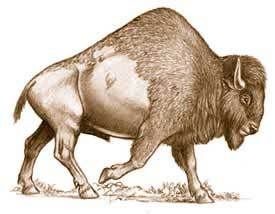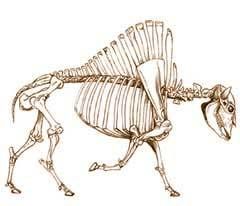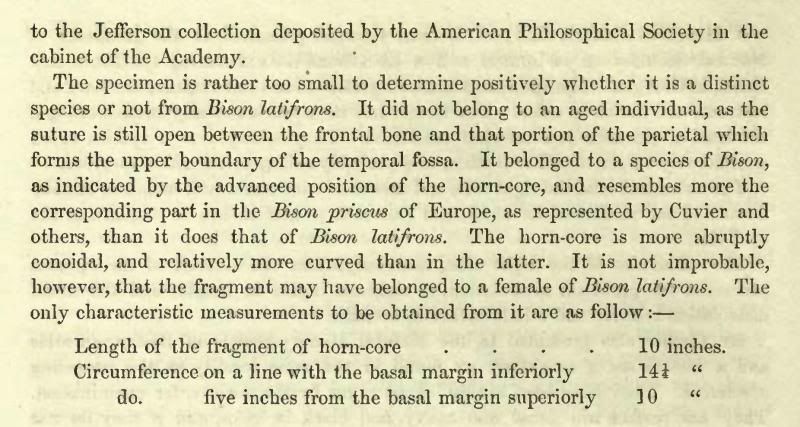|
|
Post by RSN on Jul 2, 2006 17:23:31 GMT
Ancient BisonBison antiquus Leidy, 1852  The Ancient Bison was the most common large herbivore of the North American continent and is a direct ancestor of the living North American bison. During the Pleistocene Ice Age, Steppe Wisent (Bison priscus), migrated from Siberia into Alaska. They descended to Long-horned Bison (Bison latifrons) and lived in North America for 3 million years. About 22,000 years ago, Long-horned Bison died out and gave way to the Ancient Bison. Ancient Bison were abundant 10,000 to 18,000 years ago then became extinct about 10,000 years ago and is the most commonly recovered herbivore from the La Brea tar pits. The Ancient Bison was taller, and had larger bones and horns and generally 15-25% larger than modern day bison. From tip to tip, the horns of the Bison antiquus measured approximately 3 feet. Source: en.wikipedia.org/wiki/Ancient_bison
|
|
|
|
Post by Bowhead Whale on Jul 7, 2006 19:50:56 GMT
Bisons of North-West Territories are not the same ones as those seen in the Canadian Prairies. Wood Bisons (as the first ones mentionned are called) are bigger, darker and have longer hairs. So, different kinds of bisons still coexist in North America, today.
|
|
|
|
Post by another specialist on May 23, 2008 19:12:35 GMT
Bison antiquus sometimes called the ancient bison, was the most common large herbivore of the North American continent for over ten thousand years, and is a direct ancestor of the living American bison. During the Pleistocene Ice Age, steppe wisent (Bison priscus), migrated from Siberia into Alaska. This species then developed into the long-horned bison (Bison latifrons) which lived in North America for 3 million years. About 22,000 years ago, the long-horned bison gave way[clarify] to the Bison antiquus. B. antiquus were abundant from 18,000 years ago until about 10,000 years ago, when they became extinct, along with most of the Pleistocene megafauna. B. antiquus is the most commonly recovered herbivore from the La Brea tar pits. B. antiquus was taller, had larger bones and horns and was 15-25% larger overall than modern bison. From tip to tip, the horns of B. antiquus measured approximately 3 feet (nearly one meter). en.wikipedia.org/wiki/Ancient_Bison |
|
|
|
Post by another specialist on May 23, 2008 19:14:08 GMT
|
|
|
|
Post by another specialist on May 23, 2008 19:16:00 GMT
|
|
|
|
Post by another specialist on May 23, 2008 19:20:06 GMT
HOLOCENE EPISODIC LANDSCAPE CHANGE AND THE HUDSON-MENG BISON KILL SITE, NORTHWESTERN NEBRASKA, U.S.A BALMAT, Jennifer, BALMAT, Joshua W., LEITE, Michael B., and LAGARRY, Hannan E., Physical and Life Sciences, Chadron State College, 1000 Main Street, Chadron, NE 69337, jebalm@csc.edu The Hudson-Meng bison kill site, located on a north-facing upland slope of the Pine Ridge escarpment in northwestern Nebraska, is an early Holocene mass death assemblage of Bison antiquus. Radiocarbon dates of the bone bed date it at 9,820 years b.p. +/- 160 years. The goal of this study is to identify and define sedimentary units preserved at the site to better understand the depositional environment and landscape changes before, during, and after deposition of the bison assemblage. The oldest unit, a clayey silt with mottled Munsell colors 10YR 4/2 and 10YR 5/3 containing fresh water snails and hackberry seeds represents a paludal environment. A fine sandy silt, color 2.5Y 4/2, indicates a change to an eolian depositional environment. This unit contains multiple thinly-developed paleosols; the bone bed rests upon the youngest. A massive, carbonate-rich silty fine sand, color 10YR 4/3, is eolian and preserves the bone bed. The fine to coarse poorly sorted sand, color range of 5Y 3/2 - 5Y 6/3 and 10 YR 3/2 - 5/3, represents eolian deposition with frequent colluvial additions. A very fine sandy silt deposit, colors 10YR 2/1 - 4/3, is eolian. A fine sand, color 10YR 3/1, contains the modern soil and is eolian. Colluvial cobble lenses found throughout the site can not be correlated. Except for the modern soil, the eolian units contain multiple paleosols, likely entisols, indicating intermittent periods of landscape stability during rapid landscape evolution throughout the Holocene. The change in depositional environments observed at the site coincides with climate change, episodic erosion and filling of small valleys with eolian sediments, and reactivation of sand dunes throughout the Great Plains region. gsa.confex.com/gsa/2007AM/finalprogram/abstract_131874.htm |
|
|
|
Post by another specialist on May 24, 2008 4:26:26 GMT
|
|
|
|
Post by another specialist on May 26, 2008 5:56:03 GMT
Ancient Bison Bison Antiquus   The ancient bison, the most common large herbivore recovered from the asphalt deposits, is a direct ancestor of the living North American bison. By examining the bison fossils at Rancho La Brea, paleontologists have discovered that these animals were migratory animals, similar to their modern day descendants. This conclusion was first proposed when scientists discovered that all the juvenile (young) bison within the fossil record fit into specific age groups. By examining the bison jaws for the presence of baby and permanent teeth, paleontologists concluded that all the bison found were either 2-4 months old, 14-16 months old, or 26-30 months old. No bison fossils have been found that do not fit into this annual pattern. This pattern indicates that bison were at Rancho La Brea for only a few months at a time. If the calves of ancient bison were born in early spring like their modern day relatives, then the bison would have traveled through the area each year during late spring. www.tarpits.org/education/guide/flora/bison.html |
|
|
|
Post by another specialist on Aug 11, 2008 16:45:05 GMT
 The Long Hunt By Ted Franklin Belue |
|
|
|
Post by richardrli on Aug 19, 2008 14:32:04 GMT
Bison Antiquus had no horn? Surely that's a mistake!?
|
|
|
|
Post by another specialist on Aug 19, 2008 15:31:53 GMT
Bison Antiquus had no horn? Surely that's a mistake!? Yes, That would be a mistake as the images show it definately had horns although they were shorter in length. |
|
|
|
Post by another specialist on Dec 18, 2008 20:51:29 GMT
   Memoir on the extinct species of American ox (1852]) Author: Leidy, Joseph, 1823-1891 |
|
|
|
Post by surroundx on Oct 31, 2015 3:19:16 GMT
|
|
|
|
Post by surroundx on Oct 31, 2015 3:19:48 GMT
|
|
|
|
Post by Peter on Nov 7, 2015 13:30:25 GMT
|
|
|
|
Post by surroundx on Aug 17, 2016 11:59:22 GMT
|
|
|
|
Post by surroundx on Nov 19, 2016 13:01:06 GMT
Jones,Davis Brent and Desantis, Larisa R. G. (In Press, 2016). Dietary ecology of ungulates from the La Brea tar pits in southern California: A multi-proxy approach. Palaeogeography, Palaeoclimatology, Palaeoecology. dx.doi.org/10.1016/j.palaeo.2016.11.019 [ Abstract] |
|
|
|
Post by surroundx on Nov 25, 2017 6:56:54 GMT
Extinct bison bone found on Peninsula shows earliest sign of human existence in CaliforniaFive faint butchering cuts in an ancient bison bone found in Lunada Canyon show that humans existed in California at least 500 years earlier than previously believed. The bone is part of a pelvis from a now-extinct species, Bison Antiquus. Cal State Long Beach’s anthropology department tested the specimen, determining the bone was 13,500 years old and the cuts were made by ancient human tools. “It’s one of the oldest signs of humans in California,” said Joe Cocke, who found the bone in 2012. He is also the docent at the Point Vicente Interpretive Center, where the bone is on display. Read more: www.dailybreeze.com/2017/11/24/extinct-bison-bone-found-on-peninsula-shows-earliest-sign-of-human-existence-in-california/
|
|
|
|
Post by surroundx on Jul 1, 2018 6:36:48 GMT
Díaz-Sibaja, Roberto et al. (2018). A combined mesowear analysis of Mexican Bison antiquus shows a generalist diet with geographical variation. Journal of Paleontology. doi.org/10.1017/jpa.2018.19 [ Abstract] |
|
|
|
Post by Sebbe on Aug 5, 2024 19:39:08 GMT
|
|